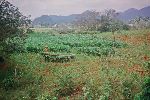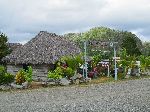| . | ||
Pinar
del Rio
|
||
Agrarian Culture and Economy |
||
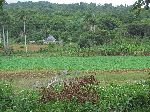  This
page covers a distance of about 25km (15 miles). The journey tells a lot of
the nuts and bolts agricultural and rural story of Cuba. What it misses nuts and
bolts is the
hundreds of greetings and dozen of conversation that were also part of the
experience. And, as multifaceted and thorough as it was, if we did it again
on another day, and especially in another seasons, we would come away with a
wealth of additional impressions and knowledge. This
page covers a distance of about 25km (15 miles). The journey tells a lot of
the nuts and bolts agricultural and rural story of Cuba. What it misses nuts and
bolts is the
hundreds of greetings and dozen of conversation that were also part of the
experience. And, as multifaceted and thorough as it was, if we did it again
on another day, and especially in another seasons, we would come away with a
wealth of additional impressions and knowledge.Just in this first picture we see a classic bohio (house), bananas and beans and other crops and a variety of vegetation. |
||
| One characteristic of homes in Pinar del Rio is color and gardens. Most rural houses have a covered porch with two large rocking chairs. It is a bit of a surprise when they don't. Most house also have electricity, piped water, and solid floors. | ||
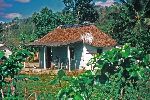
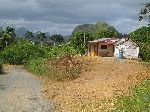
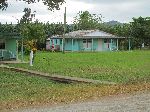
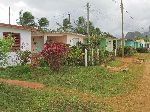
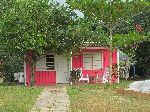 |
||
|
One of the first commodities we pointed out was coffee and coffee dry in
yards and along the road, but there is no pictures of it along this section.
Perhaps because it was too common. Coffee is the primary cash crop in some
communities, especially those more in the hills. It is often grown right around
the house. A fine Arabica varietal is cultivated here. Most of it is shade grown
so is mixed in with a canopy of other trees and can be hard to spot. The harvest
season is from July to February. As an agricultural crop, it is second only to
tobacco in this district. Coffee is grown in all of the mountain regions of
Cuba.
It only became legal to export Cuban coffee to the USA in 2016. This should lead to a surge in demand, which should lead to new planting. It take about five years for a coffee plant to mature so it should be a sellers market for a few years. |
||
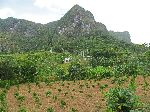 A
young mango orchard (left). They are generally ripe in the spring.
The mango is an excellent nutritional source, containing many vitamins,
minerals, and antioxidants, as well as enzymes such as magneferin and
lactase which aid in digestion and intestinal health. A
young mango orchard (left). They are generally ripe in the spring.
The mango is an excellent nutritional source, containing many vitamins,
minerals, and antioxidants, as well as enzymes such as magneferin and
lactase which aid in digestion and intestinal health. |
||
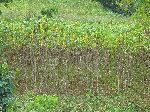 Like much of the
topical world, cassava (English) or manioc (French) is grown and eaten in
Cuba (right).
The Spanish name is yucca. It is favored because it yields a large
amount of carbohydrate per area cultivated, can be left in the ground for
years and harvested when alternatives are not available. There are several very
delicious Cuban of yucca, all of which seem to feature a generous amount of garlic sauce. Like much of the
topical world, cassava (English) or manioc (French) is grown and eaten in
Cuba (right).
The Spanish name is yucca. It is favored because it yields a large
amount of carbohydrate per area cultivated, can be left in the ground for
years and harvested when alternatives are not available. There are several very
delicious Cuban of yucca, all of which seem to feature a generous amount of garlic sauce. |
||
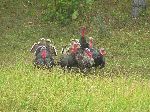 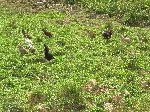 Turkeys
are a north American bird, and chickens were domesticated in
Asia. Both can be found in Cuba. Turkey (left) is rarely on restaurant menus.
But chicken
is at least, if not more common than pork. These chickens were free range,
but large numbers of chickens are raised by agro-industry in large
complexes of chicken houses. Cuba also imported
$147.5 million worth of chicken from the USA in 2014 -- over 300 million kg. Turkeys
are a north American bird, and chickens were domesticated in
Asia. Both can be found in Cuba. Turkey (left) is rarely on restaurant menus.
But chicken
is at least, if not more common than pork. These chickens were free range,
but large numbers of chickens are raised by agro-industry in large
complexes of chicken houses. Cuba also imported
$147.5 million worth of chicken from the USA in 2014 -- over 300 million kg. |
||
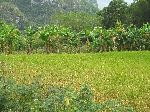 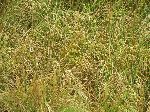 Rice
and beans are a mainstay of the Cuban diet.
Worldwide, rice provides more than one fifth of the calories consumed by
humans. Rice cultivation is well-suited to countries and regions with low
labor costs and high rainfall, as it is very labor-intensive to cultivate
and requires plenty of water for cultivation. Mechanical harvesters are few
and far between in Western Cuba. Rice
and beans are a mainstay of the Cuban diet.
Worldwide, rice provides more than one fifth of the calories consumed by
humans. Rice cultivation is well-suited to countries and regions with low
labor costs and high rainfall, as it is very labor-intensive to cultivate
and requires plenty of water for cultivation. Mechanical harvesters are few
and far between in Western Cuba. |
||
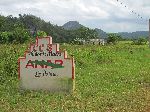 This
is a common style of sign in rural Pinar del Rio. ANAP is the Asociación
Nacional de Agricultores Pequeños (National Association of Small-holder
Farmers). CCS (Cooperativas de Créditos y Servicios) is an
ANAP program. The black lettering at the top is the name of the community, and
the lettering at the bottom is the district. ANAP was formed
in 1961 and its membership was limited to farmers whose land holdings were
less than 67 hectares. The government supported ANAP by providing
interest-free loans to its members. In 1977, ANAP supported the gradual
transformation of the private sector. Individual farmers were encouraged to
voluntarily join production co-operatives. By 1987, co-operative farms were
accounting for 63% of private land holdings nationally. Altogether 1,400
co-operative farms had 68,000 co-operative members. These numbers have since
grown considerably. In 2007, ANAP members
produce 52% of the vegetables, 67% of the corn, and 85% of the tobacco grown
in Cuba. This
is a common style of sign in rural Pinar del Rio. ANAP is the Asociación
Nacional de Agricultores Pequeños (National Association of Small-holder
Farmers). CCS (Cooperativas de Créditos y Servicios) is an
ANAP program. The black lettering at the top is the name of the community, and
the lettering at the bottom is the district. ANAP was formed
in 1961 and its membership was limited to farmers whose land holdings were
less than 67 hectares. The government supported ANAP by providing
interest-free loans to its members. In 1977, ANAP supported the gradual
transformation of the private sector. Individual farmers were encouraged to
voluntarily join production co-operatives. By 1987, co-operative farms were
accounting for 63% of private land holdings nationally. Altogether 1,400
co-operative farms had 68,000 co-operative members. These numbers have since
grown considerably. In 2007, ANAP members
produce 52% of the vegetables, 67% of the corn, and 85% of the tobacco grown
in Cuba. |
||
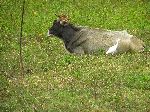 From
the time of the revolution to the first decade of the century, Cuba lost
more than two-thirds of its cattle population. Beef are still quite
rare but can be found in the market. But there seems to have been more
success at reversing Cuba's legendary milk shortage. Dairy products (milk
and cheese) have become regularly available. Pregnant woman and children
under 7, still get extra milk rations at a hugely subsidized price. It
should be noted that the scarcity of cattle here is understandable because
this is not a primary cattle raising area. From
the time of the revolution to the first decade of the century, Cuba lost
more than two-thirds of its cattle population. Beef are still quite
rare but can be found in the market. But there seems to have been more
success at reversing Cuba's legendary milk shortage. Dairy products (milk
and cheese) have become regularly available. Pregnant woman and children
under 7, still get extra milk rations at a hugely subsidized price. It
should be noted that the scarcity of cattle here is understandable because
this is not a primary cattle raising area.Nationally, cattle are a serious issue. A person can get almost as much jail time for killing a cow as killing a human. Under Cuban law, cow killers can get four to 20 years in prison. It has been said that developing a healthy livestock industry requires the hard work of thousands of farmers, but that, to ruin it, one inept official will suffice. The cattle egret, with the cow, is a bird that seeks out cattle (and other large grazing mammals) to opportunistically feed on the insects they carry and disturb. Originally native to parts of Asia, Africa and Europe, it has undergone a rapid expansion in its distribution and successfully colonized much of the rest of the world in the last century. |
||
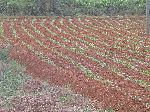
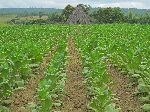

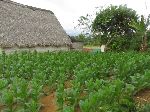
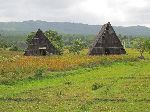 |
||
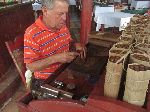
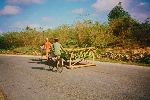 Pinar del Rio is known for the quality of its
tobacco. Tobacco quality is a
function of the soil, climate, care and curing. To cure the leaves are tied in
small bunches, hung over poles in the fields. The poles are then transported to
the curing shed, sometimes on animal drawn sleds (right). In the sheds, which
often have a thatched roof, the poles are hung on scaffoldings, that reach from
floor to ceiling. The goal is for the tobacco to cure slowly so that it is as
soft as fine suede. If it dries too much it becomes crisp and brittle, and can't
be rolled into cigars. Pinar del Rio is known for the quality of its
tobacco. Tobacco quality is a
function of the soil, climate, care and curing. To cure the leaves are tied in
small bunches, hung over poles in the fields. The poles are then transported to
the curing shed, sometimes on animal drawn sleds (right). In the sheds, which
often have a thatched roof, the poles are hung on scaffoldings, that reach from
floor to ceiling. The goal is for the tobacco to cure slowly so that it is as
soft as fine suede. If it dries too much it becomes crisp and brittle, and can't
be rolled into cigars.The region is not as famous for its cigars, but there are a few cigar factors. |
||
|
|
||
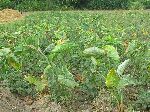 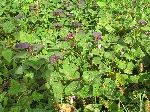 Malanga
(left)
and sweet potato leaf (right) Malanga
(left)
and sweet potato leaf (right) |
||
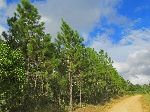
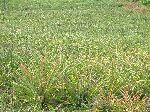 Pine forest
(left) and pineapple (right) Pine forest
(left) and pineapple (right) |
||
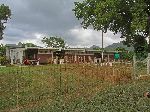
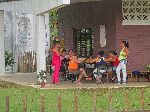 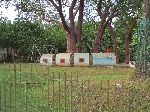 Most
of the schools in rural areas are primary schools. Many are much more robust
than you might expect for the location. It is another demonstration of Cuba's
nationwide commitment to education. Many of the schools have creatively designed
play equipment (right) because development of the whole body is emphasized, as
well. It might be a product of circumstance, but at least on this day the
teacher's lounge / lunchroom was outside. Most
of the schools in rural areas are primary schools. Many are much more robust
than you might expect for the location. It is another demonstration of Cuba's
nationwide commitment to education. Many of the schools have creatively designed
play equipment (right) because development of the whole body is emphasized, as
well. It might be a product of circumstance, but at least on this day the
teacher's lounge / lunchroom was outside. |
||
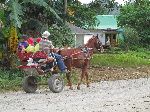
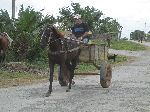
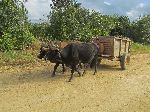
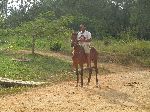
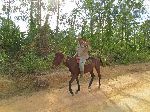 |
||
| Inventorying the rural transportation options, a lot of people are moved on foot. Of the intermediate options, horses and horse carts seem to be the most prevalent. Trailing in popularity, by a lot, are bicycles and ox cart. There are pockets of greater bicycle us. | ||

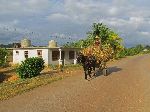
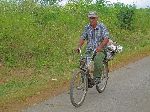
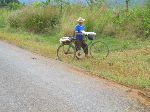
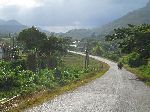 |
||
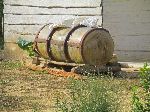
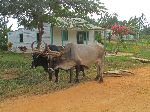
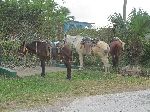 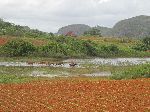 A
few more related observation: A horse parking lot (far left), horse taking a
shortcut across a lake (left), ox chilling (right), and a water tank on a sled
(far right). A
few more related observation: A horse parking lot (far left), horse taking a
shortcut across a lake (left), ox chilling (right), and a water tank on a sled
(far right). |
||
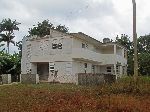 Almost
every town, even quite small towns, have a family medical clinic. These are
distinctive and discernable by their identical design. The clinics are on the
ground floor, and the second floor has two separate apartments, one for the
doctor and one for the nurse. Almost
every town, even quite small towns, have a family medical clinic. These are
distinctive and discernable by their identical design. The clinics are on the
ground floor, and the second floor has two separate apartments, one for the
doctor and one for the nurse.
Not as universal, but still fairly common, are one to a cluster of Soviet-era housing block, in towns that are otherwise single-family houses. These too all seem to have identical architecture. |
||
|
|
||
|
|
||
    |
||
|
"Hosted by
DreamHost - earth friendly web hosting"
|
||
|
|
|
